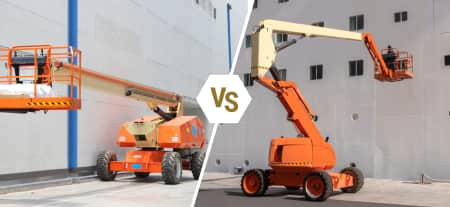Articulating vs. Straight Boom Lifts: How To Pick the Right Boom Lift
Between the different categories of aerial lifts, it can be difficult to identify which one will best meet your performance expectations. That's why it's important to understand the similarities and differences between straight and articulating boom lifts, along with their respective applications.
How are straight (telescopic) and articulating boom lifts different?
Straight and articulating boom lifts both transport people and materials to elevated workspaces. Although they share the same general purpose, their distinct features provide different functionalities that are better suited to different tasks. It's also important to note that straight boom lifts are also known as telescopic boom lifts.
Below you'll find a breakdown of the main differences between articulating and straight booms and the implications of those differences.
Vertical and Horizontal Reach
Structurally, articulating and telescopic boom lift arms have their own unique movement pattern. An articulating boom lift has an arm with bendable joints or knuckles. This enables the machine to reach up, around, and over objects in its path by being able to change its angle of approach. The telescopic boom lift arm is straight, non-bending, and can only extend straight out or upwards.
The structure of each boom's arm really affects its reach capabilities. Generally, straight boom lifts have higher vertical reach than articulating models, which is measured by how high upward the arm can extend. Telescopic booms can reach up to 210', while their articulating counterparts can only reach up to 150'.
Straight booms can also extend further out horizontally. The extra horizontal reach achieved with an extendable boom allows the operator to approach objects from afar.
You may be wondering why anyone would opt for an articulating boom lift after hearing they have less horizontal and vertical reach. Although this is the case, articulated booms specialize in maneuverability. Articulated lifts can't reach as far out, but their bendable joints allow you to approach the work site from multiple angles and navigate tight spaces with ease.
Operating Conditions
As previously stated, articulated lifts can bend around beams and corners, while straight boom lifts can access higher elevations. So, the type of movement required on site is the main determinant as to which machine you choose.
Indoor and outdoor operation is another factor to consider. Both types of boom lifts can perform work on indoor and outdoor job sites but articulating boom lifts are more popular for indoor use since these environments have limited maneuvering space and contain more obstacles. Light fixtures, tight corners, and rafters are mostly encountered indoors, making articulating lifts a better option.
Because of this, it's more common to find electric articulating lifts as opposed to telescopic ones. However, more manufacturers are offering electric telescopic models fit for indoor use.
The final operating condition to consider is navigational space. Since a straight boom lift's arm is always extended, you need more space on-site to turn the machine. Articulating lifts are much more mobile, as the cabin can swivel and the arm can bend inwards to accommodate job sites with space restrictions.
Straight and Articulating Boom Lift Similarities
From a structural standpoint, straight and articulating boom lifts are relatively similar. They both contain a platform and machine base, which moves on wheels and includes the cabin. How the arm operates and the existence of a jib, a mini arm providing additional reach commonly found on articulating boom lifts, is the main structural difference.
In terms of operation, manufacturers produce rough terrain articulating and straight boom lifts. Both types are rugged machines that are suitable for tough work on uneven outdoor surfaces. Offering both boom lift types as rough terrain models ensures that you get the kind of mobility you need in the equipment you choose.
When to Use an Articulating Boom Lift
If your job site requires any of the articulating boom lift features listed above, then it's best to choose that model. The following job site circumstances are best suited to an articulated lift.
- Crowded job sites
- Confined spaces with a restricted movement capacity
- Buildings with complex fixtures that require navigation and flexible movement
- When close proximity to the work surface is required
- When the work surface needs to be approached from different angles
- When you need to move up and over obstacles to reach the work surface
- The required vertical height is less than or equal to 150'
Due to their extensive range of motion and flexibility, articulating boom lifts work well when painting high ceilings and intricate spaces, maneuvering around power lines and trees to fix street lights, picking fruit, installing light fixtures in tough spots, and cleaning out eavestroughs.
When to Use a Straight Boom Lift
For jobs that require extensive reach, straight boom lifts are the way to go. The following job site circumstances are best suited to a telescopic boom.
- Open-space job sites
- Simplistic, accessible work surfaces with no obstacles in the boom's path
- Requires significant horizontal and vertical reach (high-rise buildings)
- Requires stability at high elevations
- Requires greater lift capacity
- Requires greater distance from the work surface
- Only need to access the work surface from one primary angle
- The required vertical height is between 150 and 210 feet
Because of their dependable stability, telescoping booms keep people safe while working at elevated workstations. They're typically used for scaffolding, repairs, painting, and electric work, among other jobs.
Need to Rent a Boom Lift?
The easiest way to summarize the main difference between both boom lifts is as follows: straight boom lifts are the best man lifts for jobs that require high-reach access or long reach whereas articulated lifts are best when a job site has many spatial limitations and requires hard-to-reach access.
For your next elevated workspace project, you can rent an articulating or straight boom lift with DOZR Marketplace!

